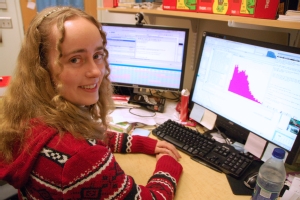2012 JSA Postdoctoral Research Grant Winner Takes Aim at Never-Before-Seen State of Matter
 Phillips, a research scientist at the University of New Hampshire, was selected for the grant by the Users Group Board of Directors, the governing body of the group that represents scientists who use Jefferson Lab facilities to conduct nuclear physics research. In making the award, the board judged each applicant on his or her record of accomplishment in physics, proposed use of the research grant and the likelihood of further accomplishments in the Jefferson Lab research fields.
Phillips, a research scientist at the University of New Hampshire, was selected for the grant by the Users Group Board of Directors, the governing body of the group that represents scientists who use Jefferson Lab facilities to conduct nuclear physics research. In making the award, the board judged each applicant on his or her record of accomplishment in physics, proposed use of the research grant and the likelihood of further accomplishments in the Jefferson Lab research fields.
"Now in its 5th year, the JSA Postdoctoral Research Grant competition has once again attracted outstanding candidates who proposed truly innovative and unique projects to be funded by the prize money. The User Group Board of Directors had a difficult choice to make - we wish we could have funded them all!" says Sebastian Kuhn, board chairman and a professor of physics and eminent scholar at Old Dominion University.
"Jefferson Lab has many outstanding scientists. We are pleased to support Sarah's research and all of us look forward to the results from her challenging experiment," said Hugh Montgomery, JSA president and Jefferson Lab director.
Phillips will use the $10,000 grant to build a piece of equipment for an experiment to see a predicted, but never-before-seen state of matter called true muonium. True muonium can be thought of as a rare atom made out of two particles that are similar to electrons, called muons. Muons are produced high above Earth when cosmic rays strike the atmosphere. Two types of muons, a muon and an antimuon, combine to from true muonium.
"It's quite rare. And I think that's probably why it hasn't been observed before. Unless you were specifically looking for it, you'd just completely miss it, I think," Phillips says.
Phillips hopes to add the search for true muonium to an existing experiment that will slam energetic electrons from Jefferson Lab's CEBAF accelerator into a target made of tungsten to produce heavy photons, which are particles that may interact with dark matter. According to theoretical calculations, this experiment is also likely to produce true muonium.
"We're expecting to only produce around 100 or 150 in the standard setup. It seems that you can produce more if you change your target to optimize it for true muonium, so that's what the proposal is for: To try to optimize it so that we can make more of the true muonium atoms, to have a better chance at not only proving them, but trying to study them," Phillips explains.
The project's unique focus impressed the board, according to Kuhn.
"In the end, the proposal by Sarah Phillips stood out because it appeared to be literally a 'one-person project' that pushes a completely new experimental initiative. The board also noted Sarah's outreach efforts and her role in inspiring younger students," Kuhn says.
Phillips says mentoring the next generation of scientists is an important part of her duties at the University of New Hampshire, and she looks forward to working with students in the lab daily.
"For a lot of them, it's the first time that they actually get to do any research. They really get the opportunity to gets their hands dirty and do some things in the lab, and they just love it," she says.
Phillips earned her B.S. in physics at Mississippi State University and her M.S. and Ph.D. at The College of William & Mary.
The JSA Postdoctoral Research Grant has been awarded annually since 2008 by the Users Group Board of Directors. The research grant is one of the funded projects of the JSA Initiatives Fund program, provided annually by the owners of JSA to support programs, initiatives, and activities that further the scientific outreach, and promote the science, education and technology missions of Jefferson Lab and benefit the Lab user community.
Jefferson Lab is managed and operated for the U.S. Department of Energy's Office of Science by Jefferson Science Associates, LLC, a joint venture between Southeastern Universities Research Association, Inc. and CSC Applied Technologies, LLC.














